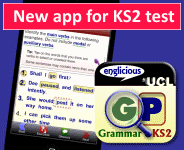Using Adverbials in Non-Fiction Texts
Goals:
- Explain what an Adverbial is and how they are formed
- Distinguish between fronted and non-fronted Adverbials
- Explore how Adverbials are used to order information.
The lesson activities are divided into part 1 and 2.
Part 1
Warmer
Use the warmer questions to introduce the topic and activate the pupils' prior learning. The next slide will give an explanation for the first three questions. Let the learners discuss their knowledge and don't worry about answering all the questions now as they will be addressed through the lesson. An overview of what Adverbials are is shown in the next slide for the learners to check their answers.
Activity 1
Tell the students that they will look at three sentences which have been broken into two parts: the main clause (A,B,C) and the Adverbial (1,2,3). Their task is to use the carousel to match the two main parts which fit best together. They can also play with the placement of the Adverbial. After they have decided, have them copy out the three complete sentences.
The next slide reveals the solution: A2, B3, C1. Remind your learners that there is no single 'correct' way to decide where the Adverbial goes. Use questions 1-3 to aid learners in discussing their choices, and speculate on the original texts.
Activity 2
Present the next slide and the idea of cohesion which most likely hepled them pair the sentence parts. Before looking at the full texts in more detail, learners will finish exploring the grammatical construction. Ask the learners to discuss what grammatical forms they think the Adverbials took in the last exercise.
On the next slide, learners match the Adverbial with the correct grammatical form. The point of this exercise is to illustrate that the grammatical function Adverbial can take various forms.
Part 2
Warmer
In this lesson, the learners will look at three texts (find the PDF file at the bottom of this page). Before reading the texts, use the warmer questions to activate the pupils' prior learning. Discuss with parnters or small groups before sharing with the whole class.
Ask learners to read the three texts and identify the genre. After two minutes, reveal the hint for extra help. The next slide reveals the solutions - accept any similar alternatives.
Activity 3
Draw the learners' attention back to the three sentences from part 1. Learners must now match those three sentences to the appropriate text and write them in the numbered space. They can also decide what order to write the Adverbial in.
The next slide reveals the solutions. Discuss with the learners what the Adverbials have in common (they are fronted) and how you can tell (they come before the Subject and use a comma). Next, learners use the bulleted-list to discuss why the Adverbial is used in each case. Accept any reasonable answers and bear in mind that more than one may be applicable.
Activity 4
Next, learners look again at the three texts and search for any other examples of Adverbials and discuss why they are employed. Share some examples and explanations with the whole class. The next slide shows some possible examples, but is not exhaustive!
Extension
Ask learners to find a recent piece of writing they have done for English or other subjects. Ask them to see what kinds of adverbials they use and how they organise their ideas. Pair and share with other learners, and discuss how they could form the sentences differerntly.
Welcome!

Englicious is totally free for everyone to use!
But in exchange, we ask that you register for an account on our site.
If you’ve already registered, you can log in straight away.
Since this is your first visit today, you can see this page by clicking the button below.
- Printer-friendly version
- Log in to view or leave comments

